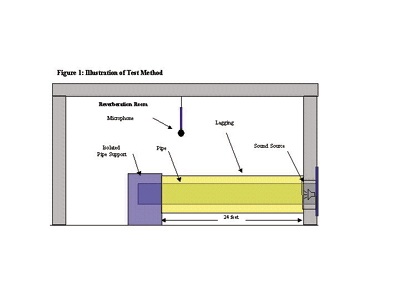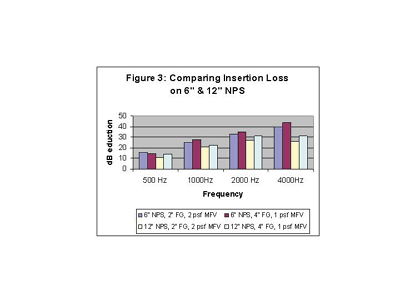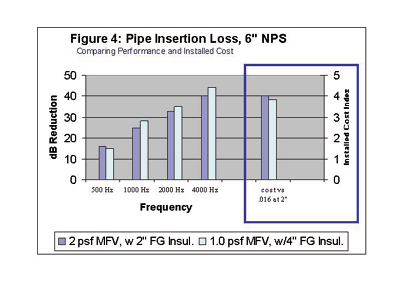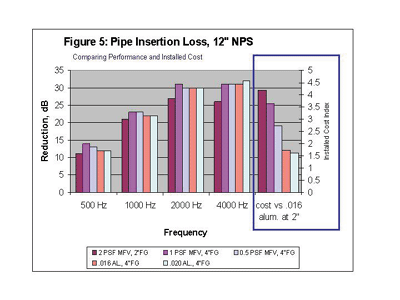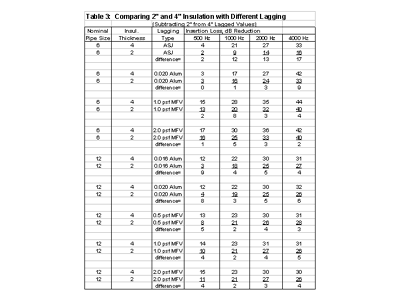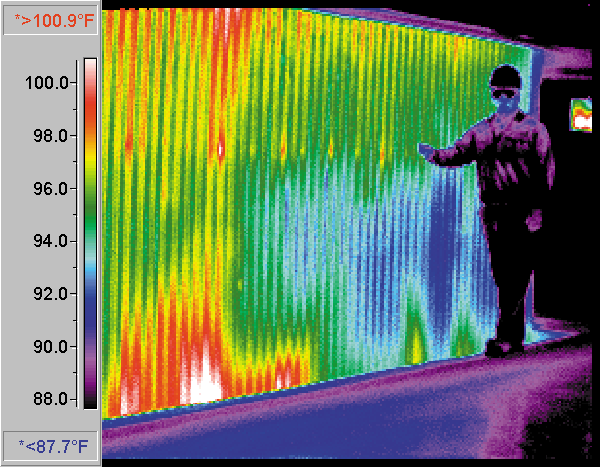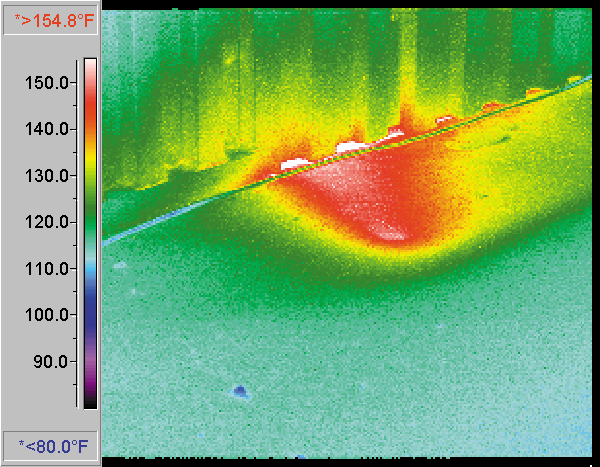After countless hours conducting research and telephone interviews regarding the many challenges an insulation contractor faces on a health care project, I have determined one issue to be of overwhelming importance:
"They don’t leave enough space for us to insulate the pipes and ducts properly. Sometimes they install the ducts against the wall and spec a continuous vapor seal. It is almost impossible to complete the specified scope of work. It is just crazy."
Too many systems and not enough room. Plumbing systems such as: sanitary and laboratory wastes; domestic, soft, and deionized water; medical and dental vacuum; compressed air; clean steam for humidifiers and sterilizers, and medical gasses. Hydronic systems such as: 125 psig steam; normal and critical chilled water and heating water; glycol run-around systems, and heat recovery chiller for domestic water preheat, cooling tower water; and HVAC ductwork the list seems endless. One on top of the other layer on layer. They are trying to squeeze ten pounds of sugar in a five pound bag.
An insulation contractor bidding on a health care project, especially retro-fit jobs, needs a project superintendent that is experienced with scheduling this kind of work in a Health care facility. A hospital is no place for "on the job" training unless the contractor has exceptionally deep pockets.
This issue is enough to make some insulation contractors by-pass the health care industry all together while others profitably thrive and flourish on these very same challenges. Why do some succeed and some run away; what’s the difference between them? Is the difference that one contractor has cultivated the knowledge, experience, confidence and creativity within the organization to succeed in servicing the health care industry and the other has not? Do you know of a contractor who has consequently been burned on a health care project?
In this article I am not going to attempt to explain how to conduct a training session regarding insulating ductwork and piping in tight spaces or to teach complex project scheduling or project management; what I will do is attempt to lift the veil covering this potentially profitable sector of the marketplace, explain some of the reasons why things are the way they are, and how an understanding of this issue can lead to success in the health care industry. I will also touch on two concepts that are gaining a strong foothold in the heath care sector that insulation contractors should address within their respective companies. Let’s address this issue one step at a time while discussing what an insulation Contractor can do to embrace the challenges and flourish in the health care industry.
"They don’t leave enough space for us to insulate "
Who is the "they" in this sentence? Are they the health care providers or building owners? The architectural design firms? The mechanical engineers? The general contractors? The mechanical contractors? Do you think these professionals, the "they", wake up every day just itching for a fight and hoping for the opportunity to make life difficult and cause problems for the insulators and insulation contractors on their projects?
Health care is not a game, it’s an industry; an industry that is important to the health of the nation it is the ground of life and death, the path of survival and hope, and it is imperative that we understand it and learn to work with it to build functional "state-of-the-art" facilities within the strained budgets and a strained economy. The health care industry has been changing since humans started thinking, walking, and talking. High-tech electronic equipment is changing faster and costing more than ever imagined. A society with unhealthy living habits and an aging "baby boom" population has made change a constant in the health care industry. As patient’s incomes are no longer guaranteed the planning, design and construction of facilities has become very important to maintain the level of care Americans demand. These changes in economics, high-tech equipment, and patient expectations are driving the industry to provide better care at cheaper costs. Change is also driven from technical advances in medicine, regulatory change from external agencies, and internal changes from re-engineering. All of these conditions are forcing administrators to redefine their roles and review their largest capital expenditures the health care facility. And these changes effect every nook and cranny of health care construction and renovation.
The insulation contractor can and should become a major force in supporting the design and construction of health care facilities as the dawn of the 21st century medicine unfolds. The insulation contractor can provide extremely valuable insights to the design and construction of an energy efficient health care facility through their knowledge of the features, advantages and benefits of insulation materials and the most effective installation methods. Fortunately there is no mystery surrounding the reduction of energy costs. The thermal insulation and heating/venting/air conditioning (HVAC) industry have clearly made this a goal for decades. New chillers, new boilers and "smart" control systems can provide maximum efficiency ONLY when properly insulated with the correct thickness of insulation. When the insulation contractor knows how to insulate the existing piping, equipment and structure cost effectively and integrate the appropriate products into the a facility it leads to a successful upgrade project. Every facility differs because its conditions and specifications are tailored to the client’s needs.
In addition to what I have mentioned above, new regulations and laws are also driving new construction and renovation of the nation’s aging health care facilities. California’s Earthquake Safety Standards law is pressuring the state’s existing hospitals to meet the new standards or rebuild by 2008, thus driving a new California health care boom. This new law is driving California’s health care providers to look at state-of-the-art facilities like these:
- St. John’s Health Center in Santa Monica, California has a flat-screen TVs in each patient’s room that can connect to the Internet. The patient’s family and friends are preparing a small meal in a kitchen just down the hall before bedtime as they settle down to stay overnight in pull-out sofa style beds. This new $314 million, 150 bed hospital and medical center is crammed with a multitude of high-tech equipment. The nearby University of California Los Angeles (UCLA) campus has two new state-of the-art hospitals under construction.
- In Otay Mesa, California, Kaiser Permanente has completed a three building, 250,000 square feet Outpatient Medical Center that is functional, aesthetically pleasing and efficient. By "efficient" I mean the building provides mechanical and safety systems with long life cycles that continue to show low operational and maintenance costs without compromising a comfortable environment for members, doctors and employees. According to sources, Kaiser is reaping over $150,000 per year in energy savings and San Diego Gas & Electric reportedly chipped in nearly $50,000 from a "Savings Through Design" program.
The country’s health care providers are beginning to systematically replace and remodel facilities as they age. They have no choice, as many of the nation’s older hospitals are expensive to operate because they consume an extremely high quantity of costly and precious energy. Health care executives are also discovering that it is often less expensive to build a new facility than it is to retrofit. The changing demographics of our population as baby boomers age is also causing the industry to look more towards rehabilitation and assisted living facilities and less in the number of hospital beds. The "over sixty" segment of the population is expected to grow by 25 percent by 2020. So even though there may be fewer beds, facilities are adding more operating rooms, larger intensive care units, and more sophisticated technology expenditures which spell out less money for bricks, mortar and mechanical equipment. With costs now over $1 million per bed, health care facility construction and renovation is an expensive and sensitive issue. The industry is in the state of continuous and unpredictable change at every level. The battle cry for owners now is "use creative style, make it user friendly, and build it for less money because the capital funds are not available."
With all of this in mind, there is no room for insulation because space costs money and health care providers are squeezing the designers and contractors to "CUT COSTS" anywhere they can. Federal cuts, rising costs, and increased competition are forcing providers to look for ways to upgrade even though they lack the capital funds to do so.
The Performance Contract
Enter the performance contract. Financing for some of these remodel projects have come through this mysterious (to the public sector) process called performance contracting. And performance contracting seems to be gaining steam in the institutional mechanical systems industry. Health care facilities are performing detailed energy studies of their facilities to determine what, if anything, can be done to save energy and reduce costs. If the analysis is done well, the provider should be able to finance and pay for the desired upgrades to the existing facility out of the energy dollars saved by the upgrade. But the catch is that in most cases the provider must guarantee that the energy savings can be obtained through the upgrades. An experienced consultant will combine the savings from electric lighting (fast payback) with the savings from chiller replacement (slower payback) and show an expectable upgrade for the owner.
Industry in the United States has not even begun to tap the $20 billion in annual wasted energy. And with the funding crisis in the health care industry performance contracting can help achieve remarkable results without an increase in their capital budgets.
The real benefits of performance contracting are that the facilities and institutions can pay for needed upgrades within their existing budget structures through the energy savings provided and the insulation contractor will benefit from the stimulation of the health care mechanical systems marketplace. The insulation industry as a whole can provide this type of service and do the work to reduce energy consumption and costs. The market is large enough to support the entire institutional insulation contractor market. Most effective energy savings upgrades include the following
- Energy Control Systems
- Efficient Motors
- Efficient Lighting
- Variable-Frequency Drives
- Steam Trap Replacement
- High Efficiency Boilers
- High Efficiency Chillers
- Thermal Building Insulation
- Piping and Ductwork Insulation
- Roof and Windows
- Variable Air Volume Replacement
- Rooftop, Pump, Fan Replacement
As you can clearly see, thermal insulation is a prominent member of this team, so the insulation contractor needs to be not only involved in this type of energy audit, but the contractor can benefit by initiating it with an energy service company (ESCO) such as the equipment manufacturer, utility company, or an engineering company specializing in the energy field.
The National Insulation Association (NIA) is poised to help insulation contractors, mechanical contractors, building owners, architects, engineers, and plant managers understand the importance of thermal insulation with the "Insulation Energy Appraisal Program". This NIA sponsored accredited training program can show industry how to significantly reduce energy costs and environmental impact. The data from the appraisal can be utilized to make sound business decisions regarding insulation that will have tremendous impact over the life of facilities throughout the United States and the entire world.
The insulation contractor must network and build partnering relationships with all the players. By taking the mystery out of thermal insulation, successful insulation contractors of the 21st century will add value to their priceless expertise in the field of energy savings, make projects happen, and not wait for the bid to come out to see the scope of the project and say "there is not enough space."
Design Build
Today we are seeing a rapidly growing trend in the health care industry towards the "design/build" method of project completion. The most significant reasons for this trend are
- Health care providers are tired of the multiple accountability that results from the more traditional methods of planning and specifying.
- Health care providers are tired of cost overruns and significant delays in construction and completion.
- Health care providers want a single agent or entity to be responsible and manage the entire process of designing, building and performance risk.
- Health care markets and players (due to consolidation mergers) are changing rapidly making the "windows of opportunity" open and close faster than ever.
- Projects must be planned, designed, and constructed faster than ever to hit the windows while they are open.
- Health care providers do not have time for the old fashioned outmoded process of plan bid design bid redesign rebid build redesign litigate etc.
Design & build has met with project success in the private commercial and industrial sectors of the construction market for years but until recently the institutional sector with its aging equipment and lack of funds has not participated due to difficult procurement rules and procedures. But the legislative changes that have taken place over the past several years have opened up this market sector. Today one of the most recognizable owners that is capitalizing on the successful possibilities of design & build is the federal government.
Conclusion
If you cannot be proactive in the business then you must understand that the overall design of a hospital building, department lay-outs, specific equipment needs and the needs of the patients and staff are prime concerns in the planning and design process and will all be developed by someone else. But if you can build a cooperative proactive team it is possible to avoid the competitive bidding process.
So, how else can the insulation contractor, one of the last trades on the job site, overcome the problems associated with the lack of work space? If you cannot get involved in the planning stage early and invest the time up front to work with the owner and designer then arm yourself with facts about the importance of a complete insulation system. Use the North American Insulation Manufacturers Association (NAIMA) 3E Plus® insulation thickness program and NIA’s Insulation Energy Appraisal Program to show the performance of the system and the value of doing the project right. Use creative problem solving techniques with your staff to provide solutions to the problems associated with lack of space. Suggestions have included pre-insulating the ductwork before installation to allow for less potential leaks in the insulation system or protecting insulated piping that could potentially be damaged by other trades with rigid jacketing. Gather as much information as early as possible and make a professional presentation to the mechanical/general contractor and owner representatives and become a performance partner with the group.
All of this information will not change the "They don’t leave enough space for us to insulate " issue and miraculously create space for the insulation contractor, but it can give you a better understanding and create closer working relationship with health care providers, the architects/designers, and the general/mechanical contractors. The rest is up to you. We all know that this issue is not going to go away in the foreseeable future because it is a real issue brought on by real challenges and real concerns in the health care industry.
Learn more about the Insulation Energy Appraisal Program or contact NIA at 703-683-6422.
Learn more about performance contracting at http://www.sustainable.doe.gov or http://eren.doe.gov

